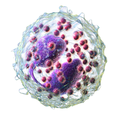Eosinophil: Difference between revisions
CSV import Tags: mobile edit mobile web edit |
CSV import |
||
| Line 29: | Line 29: | ||
{{stub}} | {{stub}} | ||
== Eosinophil == | |||
<gallery> | |||
File:Eosinophil_blood_smear.JPG|Eosinophil blood smear | |||
File:Blausen_0352_Eosinophil_(crop).png|Illustration of an eosinophil | |||
File:Hematopoiesis_simple.svg|Diagram of hematopoiesis | |||
File:Histology_of_an_eosinophil_in_esophageal_epithelium.jpg|Histology of an eosinophil in esophageal epithelium | |||
File:Reference_ranges_for_blood_tests_-_white_blood_cells.png|Reference ranges for white blood cells | |||
</gallery> | |||
Latest revision as of 04:36, 18 February 2025
Eosinophil is a type of white blood cell that is part of the immune system. It is responsible for fighting off infections and diseases, particularly those caused by parasites. Eosinophils are also involved in the body's allergic responses and in inflammation.
Function[edit]
Eosinophils function by releasing chemicals that destroy invading cells. These chemicals include eosinophil peroxidase, ribonuclease, deoxyribonucleases, lipase, plasminogen, and major basic protein. These proteins are toxic to both parasite and host tissues. In instances of diseases such as asthma or hay fever, eosinophils can cause damage by releasing their toxic granule proteins into the tissues.
Production and Life Cycle[edit]
Eosinophils are produced in the bone marrow and then migrate to tissues throughout the body. When an infection or an allergic reaction occurs, the body produces more eosinophils to fight off the invaders. The life cycle of an eosinophil is typically 8–12 hours in the bloodstream and 8–12 days in tissue.
Diseases and Disorders[edit]
Eosinophils are implicated in numerous diseases and disorders. An elevated number of eosinophils can indicate a parasitic infection, an allergic reaction, or cancer. This condition is known as eosinophilia. Conversely, a low number of eosinophils in the blood is known as eosinopenia; it can occur in certain types of severe infections or stress.
See Also[edit]
References[edit]
<references />






